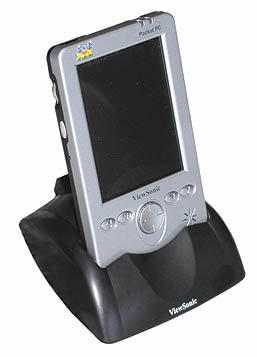ViewSonic V35 Pocket PC
High end technology at a bargain basement price
(Pen Computing Magazine, December 2002 issue) --
ViewSonic has joined the ranks of Pocket PC vendors with the ViewSonic Pocket PC V35. The company calls it the "thinnest, lightest, lowest priced device in its class," and for the most part those claims appear to be backed up. The V35 is indeed thin and light. Its 3.0 x 4.8 inch footprint is definitely at the low end of the PDA spectrum, and short of the departed credit card-sized REX, not many PDAs can match its slender profile (just 0.4 inches) and light weight (only 4.2 ounces). The V35 makes my old favorite, the also departed Casio M500 Pocket PC, look downright chunky, and even such famous lightweights as the vaunted Palm 515 aren't any thinner and actually weigh more. Some Palms are smaller (the 505 is less than 4.5 inches long, and the new Palm Tungsten under four inches until you pull out the retractable bottom part), but none is lighter.
 As far as price goes, at US$299 list, the V35 is indeed at the low end of the Pocket PC pricing spectrum that's generally in the 500 to 600 dollar range. There used to be a time when Palms were low cost and Pocket PCs were expensive, but with premium-feature Palm products from Sony and low cost Pocket PCs from Toshiba and ViewSonic, the price lines have become blurred.
As far as price goes, at US$299 list, the V35 is indeed at the low end of the Pocket PC pricing spectrum that's generally in the 500 to 600 dollar range. There used to be a time when Palms were low cost and Pocket PCs were expensive, but with premium-feature Palm products from Sony and low cost Pocket PCs from Toshiba and ViewSonic, the price lines have become blurred.
While the low price, the slender profile, and the low weight will undoubtedly help sales of the new V35, those attributes are by no means all the V35 has to offer. Unlike certain prior attempts at a lowering the cost of a complete Pocket PC, the V35 makes no compromises. True, it doesn't have internal Bluetooth or a 802.11b wireless LAN, but it does have one of the finest PDA displays we've ever seen. Like the new high-end iPAQs, ViewSonic uses a transmissive TFT. The difference between this display and the standard reflective TFTs that have been used in Pocket PCs ever since the first iPAQ pioneered their use in PDAs is simply stunning. Since the lightsource is behind the LCD, the entire display is evenly illuminated, and remains so even if you look at it from an angle. In addition, the annoying iridescent glare of sidelit reflective displays is completely gone. Indoors, this transflective display is brighter and sharper and able to display much blacker blacks. Outdoors, you give up a little bit of quality, but it is only noticeable when directly compared with a reflective display. All in all, this display is far superior and makes the V35 a pleasure to use.
Another area where the V35 breaks with tradition is in its choice of CPU where a potent yet economical 300MHz Xscale PXA250 Applications Processor replaces the old standby 206MHz StrongARM that powered Pocket PCs almost since Day One. This display/CPU combo is powered by a 900mAH internal Li-Ion battery that is supposed to last up to ten hours between charges. We didn't benchmark this, but the PXA250's lower power consumption certainly makes it possible. A new "Smart Battery" CPU setting control panel lets you choose between high and low performance settings for your preferred combination of power and battery life. This in response to one of the PXA250's new features the ability to switch between "turbo" and economy modes similar to Intel's SpeedStep architecture.
While the V35 excels in size, weight, price, and technology, it doesn't break any new ground on the design side. Unlike all those new Sonys and Handsprings and Palms that all explore new frontiers, the little ViewSonic sports a generic Pocket PC design that's changed little since the early days of the palm-size PC of two or three years ago. Put the V35 next to an old Compaq 1530 palm-size PC and they look about the same. There's nothing inherently wrong with that, but we've become so used to a constant flurry of exciting new designs that things that stay the same look sort of quaint and dated.
As is, the little ViewSonic follows the tried-and-true Pocket PC design conventions. There's a central navigation disc that overlaps the functionality of the scroll rocker on the upper left side of the device. The rocker can issue an "enter" while the disc cannot. The disc is flanked by two programmable functions keys (Notes, Contacts, Calendar, and Tasks) on each side. Below the rocker is the obligatory recording button. Push it to bring up the Notes/Voice Recorder app. Hold it down to record. Recording quality is average for Pocket PCs, which is to say marginal. The V35's on/off button is on top, right next to the stylus bay. The stylus, incidentally, is collapsible. Pull it out and it automatically extends to its full length. Push it back into its garage and it collapses. The top also features the device's IR port and a SD/MMC Card slot.
The V35 comes with a smartly styled dock with a six foot long USB cable. The small AC adapter also has a six foot cord and can be plugged either into the V35 itself or into the USB cable. I like that arrangement as it means I can charge the device without having to bring along the dock.
On the software side, the V35 features the standard Pocket PC fare--more than enough to keep most users happy.
If you are in the market for a real Pocket PC with all Pocket PC features and the latest in processor and display technology but you don't want to spend a fortune, the V35 is the perfect answer. -
Contact: ViewSonic www.viewsonic.com
|


 As far as price goes, at US$299 list, the V35 is indeed at the low end of the Pocket PC pricing spectrum that's generally in the 500 to 600 dollar range. There used to be a time when Palms were low cost and Pocket PCs were expensive, but with premium-feature Palm products from Sony and low cost Pocket PCs from Toshiba and ViewSonic, the price lines have become blurred.
As far as price goes, at US$299 list, the V35 is indeed at the low end of the Pocket PC pricing spectrum that's generally in the 500 to 600 dollar range. There used to be a time when Palms were low cost and Pocket PCs were expensive, but with premium-feature Palm products from Sony and low cost Pocket PCs from Toshiba and ViewSonic, the price lines have become blurred.